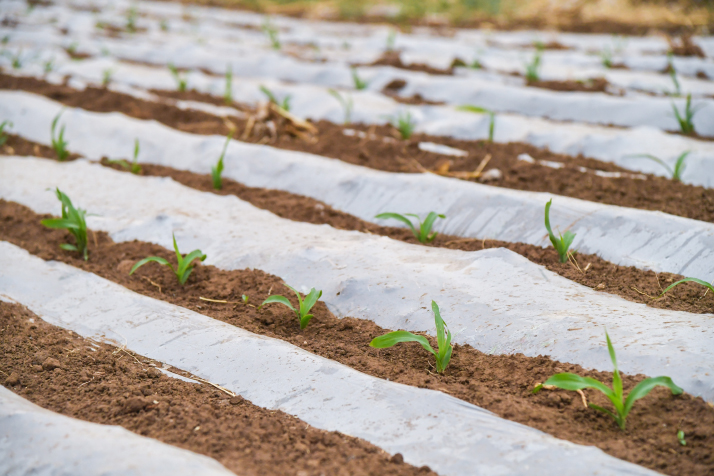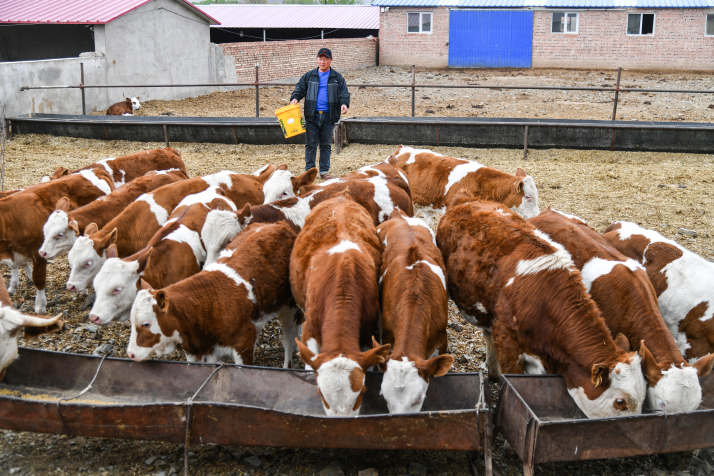| China |
| A greener grassland | |
|
|
 A plastic-mulch-covered cornfield in Xigou Village, Bairin Left Banner, Inner Mongolia Autonomous Region, on May 19 (WEI YAO)
In late May, Xigou Village was sprinkled with a few drops of rain in a thunder show lasting under half an hour. This was, however, the heaviest rainfall the village had seen in the past month. Even before the water evaporated from the shallow potholes dotting the road, a sandstorm had hit the area, forcing villager Chang Zhijun to abandon all plans of working his land that day.
The village sits in Bairin Left Banner, which falls under the administration of Chifeng City, Inner Mongolia Autonomous Region. A banner is an administrative division in Inner Mongolia, equivalent to a county in other parts of China. Located in north China, Inner Mongolia is one of the country's most ecologically fragile regions. Chang, who was born and raised here and is in his mid-50s, said that water shortage was the most pressing problem. Tech-savvy Before turning 50, Chang would spend much of his time working in the field, but his relentless efforts to fertilize the land didn't necessarily result in bumper harvests; everything depended on how much rain the parched patches would receive. As a result of global warming, extreme weather, particularly droughts, have been more frequent. But things took a turn for the better in 2019, when clean energy group China Three Gorges Corp. (TGC), which had been working to lift Bairin Left Banner out of extreme poverty as part of China's targeted poverty alleviation program, introduced the use of plastic mulch in the area. This is important for reducing evaporation, avoiding erosion and controlling soil temperature for crop production. The approach is considered climate-smart because its water-saving benefits help agriculture adapt to climate change and water scarcity. The plastic mulch also helps suppress the weeds without herbicides and use fertilizer more efficiently, thus reducing greenhouse gas emissions. Farmers are required to collect the used plastic mulch from their fields and exchange it for new covering. Though not biodegradable, this mulch is thicker than commonly used types, making it easier to be collected. The old mulch is then recycled and processed into plastic products. Biodegradable mulch is not widely applied in the banner because of its higher costs. In its efforts, the corporation was joined by The Nature Conservancy (TNC), an international environmental nonprofit organization. In China, TNC focuses on strategies that will strengthen the country's pathways for greenhouse emission reduction and climate change adaptation. Climate-smart agriculture is defined as an integrated approach to managing agriculture—cropland, livestock, forests and fisheries—that addresses the interlinked challenges of food security and climate change. Initially, villagers did not welcome the idea with open arms. Of the village's 533 hectares of arable land, only 13.33 hectares were used to test the technology. But sharp productivity gains of this small fraction of land in 2019 attracted more farmers to adopt this method the following year and today, the village's farmland is wholly covered with plastic film mulch. Chang, for one, has seen his per-hectare yield double. Even neighboring villages and towns began to learn from Xigou Village and the technology has now spread to farmable fields in many other areas in Bairin Left Banner.  A villager feeds his Simmental beef cattle in Habqil, Bairin Left Banner, on May 19 (WEI YAO)
Trash to treasure Habqil Village is a typical animal husbandry community. In the past, sheep were the village's dominant livestock type, but in recent years they have been replaced by cattle for ecological protection purposes. Unlike sheep, cattle do not eat grass down to the roots and thus pose a lesser threat to the grassland's biological environment. Also, cattle are easier to keep in captivity, which helps reduce grazing intensity to an appropriate level on chronically heavily overloaded grasslands. Since 2020, locals have switched to Simmental cows, which are bred all over the world for their high beef yields. Bayart is a 40-year-old farmer in the village. In recent years, he has continuously expanded his livestock, including 80-plus Simmentals. They give birth to about 60 calves every year and at 5 or 6 months of age, these calves can be sold. Cattle breeding turns a profit of more than 300,000 yuan ($42,270) a year for Bayart's family. Fifty households in the village are currently raising cattle at similar scales. Apart from offering loans to purchase cattle, local governments offer free husbandry management courses. Thanks to this opportunity, Bayart has not only learned how to better manage his farm but also acquired basic veterinary skills and is now able to conduct artificial insemination of his cattle. On that note, the local government also provides high-quality frozen semen to ensure premium-quality calves. However, as the local cattle-raising industry flourishes, villagers encountered a forage shortage. The fodder, the most basic and essential fuel for the cow's growth, health and production, usually comes from the grassland. But fresh grass there is available for only a relatively short period of a year and, in recent years, some of the grassland has remained untouched as part of the area's eco-conservation effort. Lin Kuocheng, Director of TNC's climate-smart agriculture program in Bairin Left Banner, suggested using silage, the preservation of green forage crops based on fermentation. After opting for silage, the fodder shortage was eased. Villagers have also found a solution to another environmental challenge—greenhouse gas emissions from cattle dung. As cows digest their food, they release methane, a greenhouse gas 28 times more potent than carbon dioxide. The methane leaves their digestive tract at both ends—through burping and a small amount through flatulence. Once out of their system, their dung continues to release small quantities of methane. Habqil raises beef cattle, whose methane emissions are half those of dairy cattle. As for their manure, half is returned to the fields as an organic fertilizer. Plus, the village opened an earthworm farm in 2022. The farm purchases manure from farmers and earthworms help convert the cow dung into vermicompost. Vermicompost is the product of a process where earthworms and microorganisms consume and break down organic materials and convert them into rich soil enhancement. Yin Xiaogang, an associate professor at the College of Agronomy and Biotechnology of China Agricultural University, is one of the agricultural scholars invited by TNC to Bairin Left Banner to undertake agricultural research in the area. His research mainly focuses on climate-smart agriculture. Yin is supportive of the local agricultural model. "To replace sheep with cattle and to adopt new agricultural technology helps a lot with local environmental protection and carbon emission reduction," he told Beijing Review. BR (Reporting from Bairin Left Banner, Inner Mongolia Autonomous Region) Copyedited by Elsbeth van Paridon Comments to weiyao@cicgamericas.com |
|
||||||||||||||||||||||||||||
|
